试讲题目2.题目:Attributive clause 2.内容: ? 3.基本要求: (1)根据所给材料,设计语法相关的教学活动; (2)配合教学内容适当板书; (3)试讲时间10分钟; (4)全英授课。 答辩题目1.请谈谈语法教学中的常见教学方法。 2.本堂课的难点在哪里? (注:以上图片节选自仁爱版九年级上册第4单元第103页)
题目
试讲题目2.题目:Attributive clause
2.内容:
?
3.基本要求:
(1)根据所给材料,设计语法相关的教学活动;
(2)配合教学内容适当板书;
(3)试讲时间10分钟;
(4)全英授课。
答辩题目1.请谈谈语法教学中的常见教学方法。
2.本堂课的难点在哪里?
(注:以上图片节选自仁爱版九年级上册第4单元第103页)
2.内容:
?

3.基本要求:
(1)根据所给材料,设计语法相关的教学活动;
(2)配合教学内容适当板书;
(3)试讲时间10分钟;
(4)全英授课。
答辩题目1.请谈谈语法教学中的常见教学方法。
2.本堂课的难点在哪里?
(注:以上图片节选自仁爱版九年级上册第4单元第103页)
相似考题
更多“试讲题目2.题目:Attributive clause ”相关问题
-
第1题:
初中物理《电流的热效应》
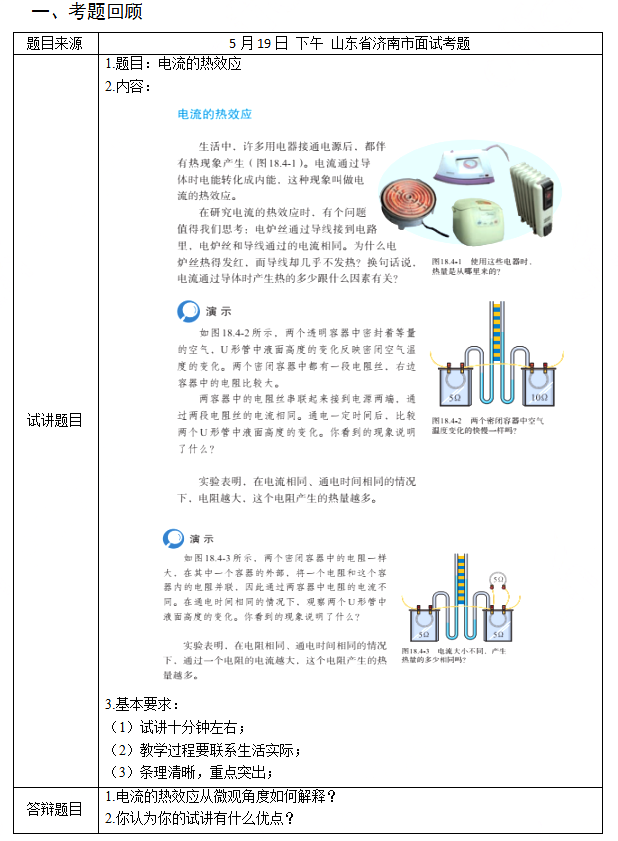

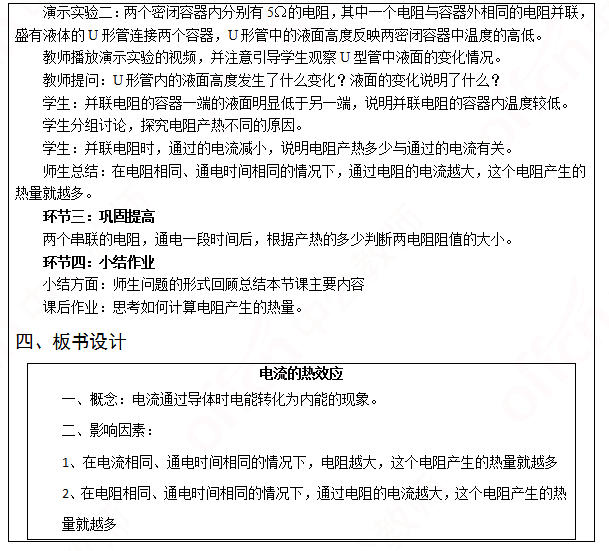
【答辩题目解析】
1.电流的热效应从微观角度如何解释?
2.你认为你的试讲有什么优点?答案:解析:1、导体通过电流时,电能转化为内能称为电流的热效应,从微观角度是因为导体中的自由电子做定向移动时,与导体中的离子不断的碰撞,同时把一部分能量传递给离子,使离子的运动加剧,从而导体发热。
2、评委老师,在我的教学过程中,多采用了生活的实例引导学生观察、思考,学生能够充分参与到课堂中,激发了学生的学习热情,而且我在讲课的过程中能围绕重点内容展开,比较好的实现了本节课预设的教学目标,在教学过程中设置了自主探究、小组讨论等环节注重结果的同时也让学生参与到了知识的形成过程中比较好的突出了学生的主体地位。 -
第2题:
高中心理健康 《人的气质类型》
一、考题预估
题目来源:5月18日 江苏省面试考题
试讲题目
1.题目:人的气质类型
2.内容:
人的气质类型主要有:胆汁质、粘液质、多血质、抑郁质。
3.基本要求:
(1)试讲时间控制在十分钟;
(2)设置师生互动环节;
(3)试讲中要注意引导性。
答辩题目
1.你的教学重点是什么?你用什么方式突出的教学重点?
2.针对不同气质类型的学生,教师应该如何做到因材施教?答案:解析:二、考题解析
【教学过程】
(一)提问导入
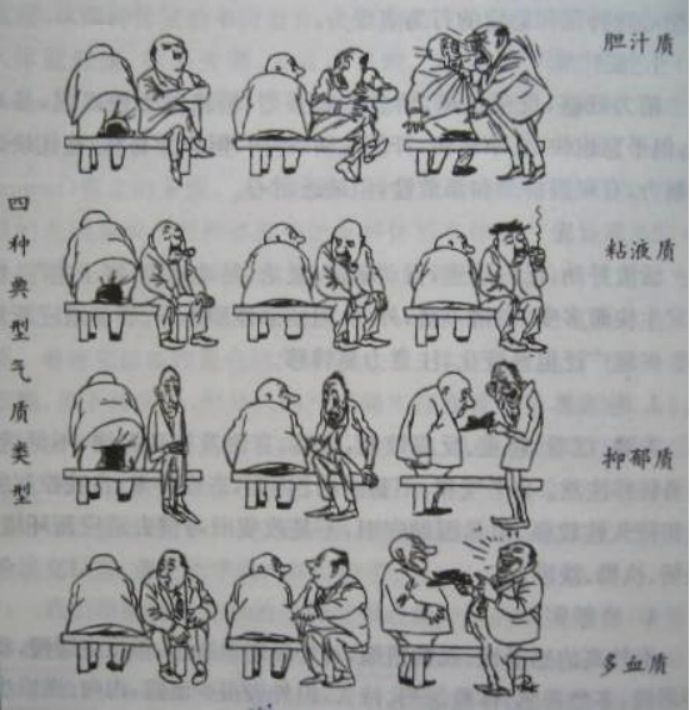
师:请问同学们在这幅图片里看到了什么呢?
生:图片里有四个人坐在一个凳子上,旁边放了一顶帽子,这里一个人过来了,不小心坐在帽子上,四个人有四种不同的表现:第一个人直接与来人打起来了,第二个看了一眼来人,接着抽自己的烟,第三个人拿起帽子伤心地对来人说我的帽子被你坐坏了,这可怎么办啊?第四个人与来人交谈甚欢,最后成为了好朋友们。
(二)课程讲授
1.气质的类型及特点:
(1)胆汁质(胆汁质的人像夏天):直率、热情、精力旺盛、生气勃勃、情绪易于冲动、心境变换剧烈、易感情用事、任性、脾气暴躁、易怒、缺乏自制力,是人们常说的急性子的人。
(2)多血质(多血质的人像春天):动作敏捷、活泼、灵活好动、热情、富于同情心、适应能力强、敏感、反应迅速、注意力容易转移、兴趣广而易变:喜欢与人交往,言语富于表达力和感染力,感情外露而易变,缺毅力和耐力,浮躁,轻率,是人们常说的活泼好动的人。
(3)粘液质(粘液质的人如冬天):沉着冷静、反应缓慢、安静、稳重踏实、沉默寡言、情绪不易外露,注意力稳定且难于转移,善于忍耐、缺乏活力、行动迟缓、为人拘谨、因循守旧等,说话少,内心少外露,情绪发展慢但持久、坚韧、执拗,是人们常说的慢性子的人。
(4)抑郁质(抑郁质的人似秋天):敏感、孤僻、行动迟缓、体验深刻、情感深入持久、善于觉察别人不易觉察到的细小事物,多愁善感,情感脆弱,畏缩而孤僻,反应慢而不灵活,胆小,是人们常说的多心的人。
特别强调:抑郁质和抑郁症是两个不同的概念,之间没有任何联系。抑郁质是一种气质,是一种美,而抑郁症则是一种心理疾病,任何一种气质的人都可能会得抑郁症,两者不可混为一谈。
2.提问环节:
(1)给每种气质类型至少列举两位相对应名人。
(2)你比较喜欢那种类型呢?为什么?
(3)现在我们以心理小组为单位来讨论一下:与不同气质类型的人交往时应该注意什么细节呢?
3.气质测试
(1)测试
成功不仅与人的智力有关,还与人的兴趣爱好、抱负水平、性格特点以及气质类型有很大的联系。清楚的了解自己的心理特点,有助于我们获得成功。你们想知道自己的气质类型吗?
请同学们,把手中的测试卷拿出来,尽快填写你看完题目后的第一印象,不要在每一道题目上费太多时间思索。答案无所谓对与不对,好与不好,完全不必有任何顾虑。做完测试后,请大家按照试卷后面的记分方法看看自己属于哪种气质类型。
(2)分享感受:
师:你觉得得出的结果基本符合自己吗?喜欢自己的气质类型吗?
(三)课后小结
今天我们大家一起学习了气质的类型及特点,也了解了在与不同气质的人打交道时应该注意的问题,相信同学们一定对自己的气质类型很好奇,我们将在下节课给大家进行气质测试,让大家了解自己所属的气质类型。
【板书设计】
人的气质类型
胆汁质
多血质
粘液质
抑郁质
【答辩题目解析】
1.你的教学重点是什么?你用什么方式突出的教学重点?
【参考答案】
这节课的教学重点是不同气质类型的特点。
为了突出教学重点,我设计了小组讨论,提出三个问题:
(1)给每种气质类型至少列举两位相对应名人。
(2)你比较喜欢那种类型呢?为什么?
(3)现在我们以心理小组为单位来讨论一下:与不同气质类型的人交往时应该注意什么细节呢?
通过三个提问,学生可以深入了解不同气质类型的特点,并且懂得,气质无好坏之分,学习针对不同气质类型的学生进行因材施教的方法。
2.针对不同气质类型的学生,教师应该如何做到因材施教?
【参考答案】
针对学生的气质差异,在教育过程中对不同气质类型的学生采取的方法应尽可能地因人而异,做到“一把钥匙开一把锁”。
(1)对于多血质的学生,可以采取多种教育方式,但要定期提醒,对其缺点严厉批评。教师可以适当地给予较多的活动与任务,并使他们从中得到更多的教育,要求他们养成踏实(不轻率)、专一和克服困难的精神;
(2)对于粘液质的学生进行教育要更加耐心,容许他们有充足的时间去考虑问题和作出反应,培养其生气勃勃的精神、热情开朗的个性和以诚待人、工作踏实、顽强的优点;
(3)对于胆汁质的学生要注意培养他们的自我克制能力,在教育过程中,教师应采取直截了当的方式,但这些学生不宜轻易激怒,对其严厉批评要有说服力,培养其自制力、坚持到底的精神,豪放、勇于进取的人格品质;
(4)对于抑郁质的学生,则应采取委婉暗示的方式,要更多地关心他们,体贴他们,鼓励他们多参加活动,不要当众指责他们,不宜过于严厉的批评,培养他们亲切、友好、善于交往、富余自信的精神,培养其敏感、机智、认真、细致、高自尊的优点。 -
第3题:
初中化学《铁的冶炼》
一、考题回顾
题目来源:5月18日 河南省濮阳市面试考题
试讲题目
1.题目:铁的冶炼
2.内容:

3.基本要求:
(1)要有适当的板书设计。
(2)试讲10分钟以内。
(3)要有师生活动。
答辩题目
1.为什么铁容易生锈直至全部锈蚀,而铝不容易锈蚀?
2.本节课为什么设计这样的作业?答案:解析:二、考题解析
【教学过程】
(一)新课导入
【教师提问】我国拥有丰富的金属资源,地壳中金属元素的含量前三是什么?提炼这些金属的原料是什么?应用最多的金属元素是什么?
【学生回答】铝、铁、钙;矿石;铁。
【教师总结】铁又是如何从矿石中提炼出来的?方法和原理是什么?今天让我们一起来学习一下《铁的冶炼》。
(二)新课教学
【教师总结】冶炼铁最常用的矿石是赤铁矿。今天我们主要以成分主要是Fe2O3的赤铁矿为例,来学习研究如何实现铁的冶炼。




-
第4题:

二、考题解析
【教案】
Teaching Aims:
Knowledge aim: Students will master the structure of attributive Clause and understand what the relative words or antecedents are.
Ability aim: Students can use the attributive clause to describe what happened in their daily life and make up more superior sentences.
Emotional aim: Students will be inspired to study both English and putonghua very well so that they can solve problems they will meet abroad by themselves.
Teaching Key Points:
Students acquire the clause structure and know the relative words as well as antecedents.
Teaching Difficult Points:
Students can apply the structure into daily communication and get the difference between relative pronoun and adverb.
Teaching Methods:题目来源于考生回忆
Communicative teaching method, task-based teaching method, situational teaching method.
Teaching Aids:
PPT, Blackboard and so on
Teaching Procedures:
Step 1: Warming up
1.Greetings
2.Review: Show students two sentences. One is an adverbial clause of place that linked by where and the other is an attributive clause that also linked by where Where there is a will there is a way. Let them find out the differences or similarities between them and lead to what we’re going to learn today.
Step 2: Presentation
1. Read the passage briefly and and answer 3 questions. Where is the Ocean park? Who helped us? How was the ride? To lead the three underlined parts Then write down the three sentences students choose from the passage after reading.
2.Explain the common parts of these three sentences and show the structure of attributive clause.
3.Tell students that when the antecedent is a person or an object, we should choose different relative words. Also, they should understand the difference between attributive clause linked by where and the adverbial clause of place linked by where.题目来源于考生回忆
Step 3: Practice
1. Give them some sentences with blankets and let them choose the proper relative words.
2. Show them several clauses and find out which are attributive clauses.
Step 4: Production
Discussion and share: students work in pairs to describe their travel by using attributive clauses; teacher will give them 5 minutes to prepare it and 5 minutes later, invite some students to share their experiences.
Step 5: Summary & Homework
Summary : students look at the blackboard and summarize this class.
Homework:students find more rules about attributive clauses and prepare for the next class.
Blackboard design:
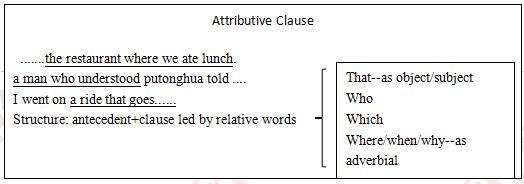 答案:解析:暂无解析
答案:解析:暂无解析 -
第5题:
《勾股定理》
一、面试考题
试讲题目
1.题目:勾股定理
2.内容:
3.基本要求:
(1)试讲时间10分钟;
(2)讲解要目的明确、条理清楚、重点突出;
(3)根据讲解的需要适当板书;
(4)学生掌握勾股定理的证明方法。
答辩题目
1.勾股定理还有哪些证明方法?
2.本节课的设计思路是什么?
注:图片节选自人民教育出版社初中数学八年级下册第23-24页答案:解析:二、考题解析
【教学过程】
(一)导入新课
复习导入:复习三角形三边关系,说明直角三角形中三边存在着更特殊的数量关系,引出课题《勾股定理》。
(二)讲解新知
(三)课堂练习
已知直角三角形的两边长为3和4,求第三边。
(四)小结作业
小结:提问学生本节课有哪些收获。
作业:搜集勾股定理的数学小典故,第二天分享交流。
【板书设计】
-
第6题:
小学美术《剪纸故事》
一、考题回顾
题目来源:5月18日上午河南省郑州市面试考题
试讲题目
1.题目:中年级《剪纸故事》教学
2.内容:
设计与制作(剪刻几个人物,将他们组合成故事,粘贴在底纸上)。

小学美术《剪纸故事》
一、考题回顾
题目来源:5月18日上午河南省郑州市面试考题
试讲题目
1.题目:中年级《剪纸故事》教学
2.内容:
设计与制作(剪刻几个人物,将他们组合成故事,粘贴在底纸上)。答案:解析:二、考题解析
【教学过程】
活动一:激趣导入
出示谜语“一张红纸不算大,剪刀代笔巧画画。画鱼画猪画人物,贴在窗上叫窗花。”提出问题:
1.这个谜语的谜底是什么?(剪纸)
2.生活中你在哪里见过剪纸?(过年的时候贴玻璃上的窗花,办喜事的时候贴门上的“囍”等等。)
教师引出剪纸是我国传统艺术,也是我们日常生活中常见的一种装饰艺术,从而引出课题《剪纸故事》。
活动二:描述分析
多媒体出示《戏剧人物》《猫捉鼠》两幅剪纸作品引导学生观察,提出问题:
1.《戏剧人物》和《猫捉鼠》这两幅剪纸有什么不同点?(《戏剧人物》剪刻精细,《猫捉鼠》剪刻粗犷。)
2.这些剪纸的相同点是什么?(头部线条比较稠密,线与线之间相连)
教师总结:由于地域的不同和生活习性的不同,造就了南北方不同的剪纸风格,南方以并且线与线之间不断开,即线线相连。精巧秀美见长,北方以粗犷简约居多。但是不管哪种风格都着重对于头部及五官的刻画。
3.展示学生作品《洗澡》、《打篮球》,请同桌之间交流,这些剪纸都在讲述什么故(表现了日常生活中有趣的事情。)
4.你想用剪纸表达什么故事?(想表现和姐姐一起跳绳的场景,和妈妈一起逛街场景,和同学一起玩皮球的场景...)
教师总结:剪纸一般都选取有情节性的故事进行剪刻,满足我们日常的审美需求。
活动三:示范讲解
教师示范“喂鸽子”剪纸作品,首先剪出人物外形,然后用刀刻出细节,最后添加组合成一个场景故事。
步骤:(1)剪外形
(2)刻细节
(3)组合添加环节
活动四:实践展评
1.布置练习:将构思好的故事情节用剪纸的方式表现出来。
2.教师巡视辅导,给予建议,鼓励学生大胆创作,剪出一个生动的故事。并提醒用刀用剪安全。组织学生展示自己的作品,并开展自评、互评和师评相结合的评价方式评价作品。
活动五:小结作业
1.小结:总结重点知识,并升华情感,引导学生珍惜、爱护和弘扬我国优秀传统艺术。
2.课下搜集我国其他传统艺术的资料,下节课交流。
【板书设计】
剪纸故事
特点:线线相连
步骤:1.剪外形,2刻细节,3.组合添加
【答辩题目解析】
1.你本堂课的情感态度和价值观目标是什么?
【参考答案】
美术是一门人文性的学科,情感态度与价值观目标在美术课程中至关重要,情感指学习兴趣、学习责任等。价值观使学生内心确立起对真善美的价值追求以及人与自然和谐和可持续发展的理念。本节课的情感、态度和价值观是学生能够养成热爱中国传统剪纸艺术,热爱传统文化的美好品德。
为了达成这一目标,我主要是在新课讲授的过程中,在新课讲授环节穿插了很多剪纸文化的讲解,以激发起学生热爱剪纸的美好情感。比如在让学生认识到南北剪纸文化的不同。在小结作业再次升华情感:剪纸世世代代传递着民族的人文精神、思想感情和风俗习惯,寄托了人们对美好生活的向往和追求,表达了人们普遍认同的生命价值和生存需求。并且通过声情并茂的讲解相信必能感染到学生。促使他们养成热爱中国传统剪纸艺术,热爱传统文化的美好品德。
2简述一下剪纸的分类。
【参考答案】
剪纸种类繁多,从式样上可分为单色剪纸、染色剪纸、分色剪纸、套色剪纸等。剪纸从用途上可分为窗花、绣花样稿、喜花、墙花、礼花、灯花等种类。一般常见的是单色剪纸,主要以红色为主。也有黑色或其他色彩的剪纸,多采取阳刻、阴刻、或阴阳并刻的艺术手法,特点是单纯、明快,对比强烈,表现力丰富。白色剪纸多为刺绣底样。 -
第7题:
小学社会《课堂作业认真做》
一、考题回顾
题目来源:5月18日北京市面试考题
试讲题目
1.题目:课堂作业认真做
2.内容:
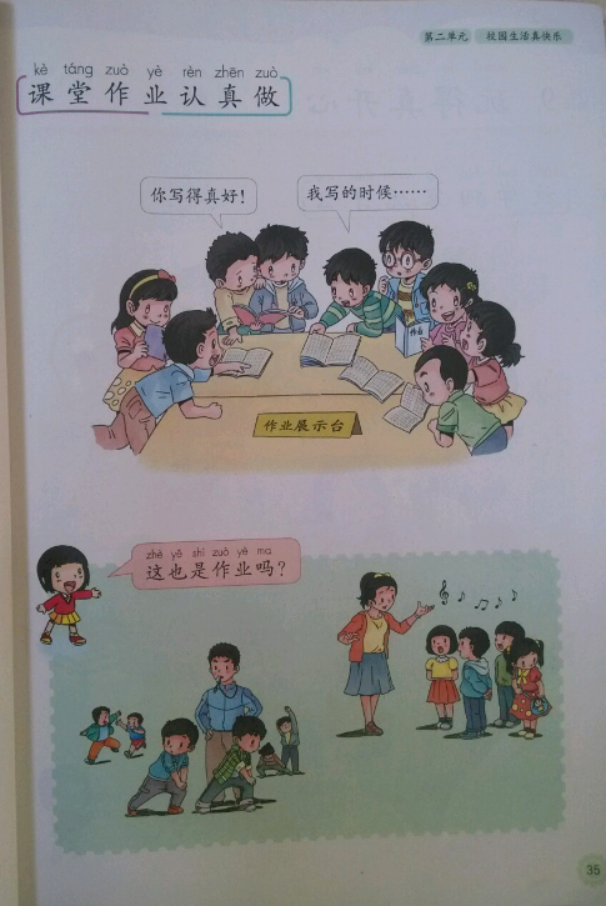
3.基本要求:
(1)教学设计要联系学生实际情况;
(2)要有适当的板书设计;
(3)要有师生互动。
(4)试讲时间不要超过10分钟。
答辩题目
1.说一说你本堂课的教学方法?
2.说说怎样认真完成不同类型的课堂作业。答案:解析:二、考题解析
【教学过程】
环节一:导入新课(故事导入)
讲述故事《高兴的花花》,花花是小学一年级的学生,今天在学校,老师夸她的课堂作业写得干净、整齐,在课堂上被老师表扬了,于是花花回家就把这个好消息告诉了妈妈。妈妈听了非常高兴,也对花花说:宝贝真棒!
提问:花花为什么受到表扬?你觉得什么事情让花花妈妈最高兴?
学生回答,教师进行引导:因为花花的课堂作业做得好,所以受到了夸奖,妈妈也非常高兴。进而引入新课《课堂作业认真做》。
环节二:新课讲授
1.书写作业认真做
首先,我们来学习最常见的书写作业怎么做。
开展“作业展示台”活动,将班级里的优秀作业放入展示台让学生观察。
提问:大家觉得他们的作业好在哪里?并请优秀作业的主人分享他们把作业做好的经验。
根据学生的回答,教师将与学生一起总结出:优秀作业字迹工整、卷面干净、准确率高。要想做出这样的作业需要做到:认真记录作老师所提出的作业要求,做作业时要静下心认真做,字迹工整,做完了之后需要检查以保证正确率。
2.其他作业多练习
过渡:刚刚所展示的都是需要我们通过书写完成的作业,除此之外,我们在平时的学习中,还有一些是不需要用到纸和笔就可以完成的,接下来我们就来看看这样的作业要怎么完成。
展示图片:一是体育课上广播体操的学习,有的小朋友在追逐打闹,没有按老师的要求完成动作;二是音乐课上的演唱练习,有个小朋友认为自己不出声也没人知道,于是没有和大家一起唱歌。
提问:上图中的几位小朋友的做法对吗?这些不用交的课堂作业应该认真完成吗?
根据学生的回答,教师与学生一起总结:这些也都是我们在课堂上要完成的作业,对我们的进步意义重大,不管哪一样课堂作业,我们都要听清楚要求,多多思考,多多练习,认真完成,这样我们的作业一定能完成得很棒。
环节三:巩固提高
播放《作业歌》:作业要求听仔细,样样作业认真做,完成作业要检查,字迹端正又整洁。利用儿歌的形式加深学生的印象并方便其记忆。
环节四:小结作业
小结:根据本框的内容特点及学生学习的特点,教师结合板书内容,采用归纳式小结,使同学们对本节课形成更清晰的认识。
作业:请同学们课下观看视频《小熊尼奥做作业》。

【答辩题目解析】
1.说一说你本堂课的教学方法?
【参考答案】
根据教材内容及学生的实际情况,我采用了谈话法、情境教学法、活动教学法。谈话法是师生互相交流的一种方法,来引导学生思考、学习,这一方法主要体现在教学过程中对于学生的提问;活动教学法主要在第一个知识点——书写作业认真做这一内容的学习,采用了作业展示台的活动来调动学生的积极性;情境教学法主要在第二个知识点的学习上,通过图片再现教学情境,激发学生的学习兴趣。
2.说说怎样认真完成不同类型的课堂作业。
【参考答案】
不管什么类型的作业,首先学生需要做到的是认真听老师提出的作业要求,做书写作业时要静下心认真做,字迹工整,做完了之后需要检查以保证正确率;非书写作业,就需要多多思考,多多练习,认真完成。这样我们的作业一定能完成得很棒。 -
第8题:
初中英语 语音
一、考题回顾
题目来源:5月19日 上午 上海市 面试考题
试讲题目
1.题目:
2.内容:
p, t的发音,浊辅音:sp, st.
teacher, place, speaking, star.
3.基本要求:
(1)讲授p, t的发音
(2)全英10分钟试讲
(3)适当板书
答辩题目
1. Do you know some subjects of teaching pronunciation?
2. What’s the principles of teaching pronunciation?答案:解析:二、考题解析
【教案】
Teaching aims:
Knowledge aim:
Students will master the pronunciation of “p”, “t”,“sp” and “st”.
Ability aim:
Students will know how to pronounce “p”, “t”,“sp” and “st” in words.
Emotional aim:
Students can foster the interest and desire of learning English, and be fond of taking part in kinds of class activities.
Key and difficult point:
Key Point:
Students can master the pronunciation of the letters and group of letters.
Students will know how to pronounce them in words.
Difficult Point:
Students can improve their confidence in learning English, and not be afraid of speaking English.
Teaching procedure:
Step 1: Warming-up
1. Greetings. Talk about the weather.
2. Show tongue twisters to the students
[p] Peter’s plane is plainly painted .Peter is paid plenty to paint planes .
[t]Too many teenagers tend to waste their time watching television.
Ask them if they can read the tongue twisters as fast as possible. Then they find it not easy to read them fluently and quickly. Later, the teacher can lead in the topic. Today we are going to learn the pronunciation about the letter “p, t”.
Step 2: Presentation
1. Listen to the recording carefully, and try to find what the listening is about. Meanwhile, circle the words with letter “p” and “t”.
2. Listen to the recording for the second time. And try to find rule of the pronunciation of letter “p” and letter “t”, and pay attention to differences of these two letters’ pronunciation in the letter group- “sp, st”. They may say that in the words like teacher and play, the letter “p” and “t” are voiceless. However, in the letter groups of “sp” and “st”, they should make a sound . And they pronounce differently.
3. Conclude the pronunciation of letter “p” and letter “t”. Tell them that the letter “p” and “t” are voiceless consonant, while in the letter groups of “sp” and “st”, the letter “p” and “t” are voiced consonant.
4. Show the pronunciation of these two letters to the students. Ask them to read after the teacher practice.
Step 3: Practice
1. Play a game named “odd one out”. Read some groups of words for the students. They should listen carefully and say which word is different.
For example: sports Spanish stupid spirit
2.Ask a few students if there are other words containing the letter “p”, “t” and the letter groups of “sp” and “st”. They may answer “pen, piano,take, talk”, “spell, spring, spirit” , “stand, stay, stop”.
3.Play a game named “send words home”. Show others words including the letter “p”, “t” and the letter groups of “sp” and “st” on the screen. Introduce the rule of the game briefly. Then invite some students to the front and write the words down on the blackboard. Check answers later.
Step4: Production
Ask students to make some sentence with the words on the blackboard in groups of 4. After 5 minutes, invite some group members to share their sentences. Give evaluation to them.
Step5: Summary and Homework
Summary: Ask a student to conclude the content of the lesson and summarize with the whole class.
Homework: Read the words and the tongue twister to their friends and make more sentences with the target letters.
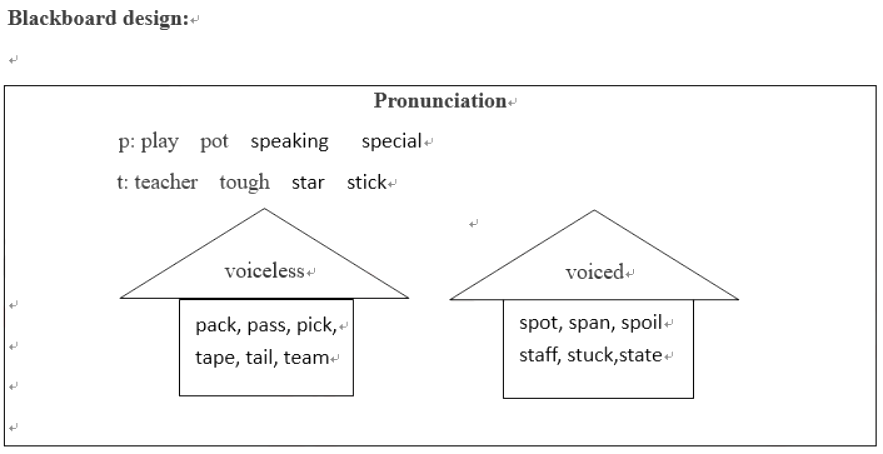
【答辩题目解析】
1. Do you know some subjects of teaching pronunciation?
【参考答案】
Well, it includes basic pronunciation such as pronunciation of 26 letters, pronunciation of vowels in the stressed syllables, pronunciation of consonant clusters and so on. It also teaches stress of words and sentences. The variation of pronunciations is the important part which deals with liaison, weak form, loss of plosion and assimilation.
2. What’s the principles of teaching pronunciation?
【参考答案】
I think it should focus on the following principles:
①Accuracy. It is the primary principle in teaching pronunciation.
②Long-tern development. Teaching pronunciation is not just a task for students who have begun to learn, it must run through all stages.
③Comprehensiveness. Teaching pronunciation is not teaching isolated speech sounds. All aspects should be included such as phonemes, phonetic symbols, words , sentences, meaning and uses. -
第9题:
高中英语?语法
一、考题回顾
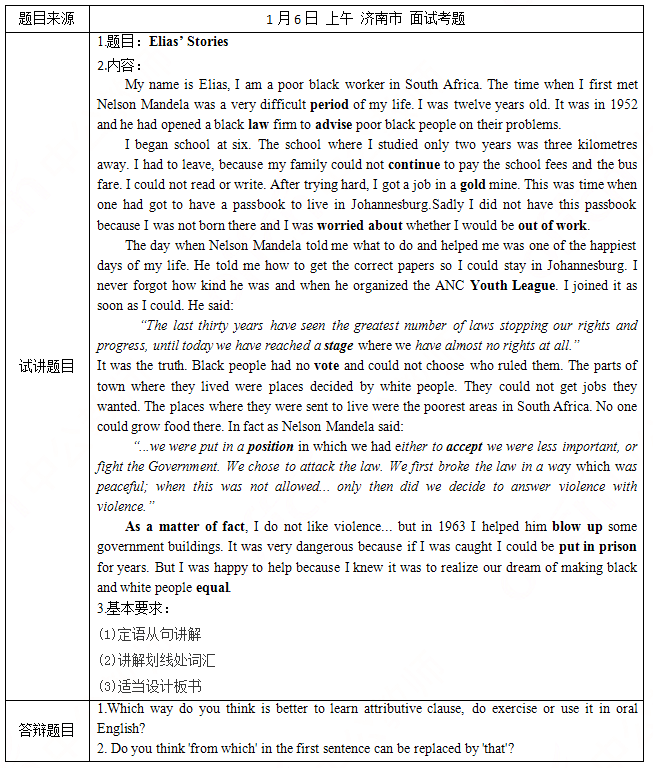
二、考题解析
【教案】
Teaching aims:
Knowledge aims:
(1)Students are able to master the meaning of bold words and phrases: period, law, advise, gold, worried about, out of work, Youth League, stage, stage, position, as a matter of fact, blow up, put in prison, equal
(2)Students can master the usage of adverb in attributive clause.
(3)After this lesson, students can know the difference of usage of adverb in attributive clause and the usage of pronoun in attributive clause.
Ability aim:
After this lesson, students can use grammar of attributive clause in reading and writing.
Emotional aim:
Students are able to love learning English after this lesson.
Key and difficult point:
Key Point: master the meaning of words and phrases :period, law, advise,gold,worried about etc.
Difficult Point: use grammar of attributive clause in reading and writing
Teaching procedures:
Step 1: Warming-up
1. Greetings.
2. Ask students to make several sentences using the grammar of usage of pronoun in attributive clause. Then write a sentence needing to use adverb in attributive clause. And then lead in the new grammar, adverb in attributive clause.
Step 2: Presentation
1.Ask students to open the book and read the passage to guess the meaning the bold words and then paraphrase the bold words with the help of PPT.
2. Then Ask students to find out more complex sentences that the clause is after a noun or pronoun and the words that are used to introduce the sentences: where, when, why or preposition plus which.
The time( when I first met Nelson Mandela )was a very difficult period of my life.
The school (where I studied only two years) was three kilometres away.
This was time (when one had got to have a passbook )to live in Johannesburg.
we were put in a position (in which we had either to accept we were less important, or fight the Government). ...
Then ask students to find the similarity of these sentences and invite several students to share their ideas. Then lead the students to conclude the rules of relative adverb in attributive clause and preposition plus which in attributive clause. (They all function as adverbials)
Step 3: Practice
1.Make sentences: Ask students to use the grammar that has just learnt to describe the pictures which are presented on the PPT.
2.Combine the sentences: Ask students to combine the sentences according to the grammar in attributive clause.
(1)This is a book. Its cover is blue. (whose)
(2)He is the teacher. He helped me. (who/that)
(3)Beijing is the place. I was born in this place. (where/ in which)
(4)This is the hotel. You will stay at the hotel. (where/at which)
Step4: Production
1.Make stories: Ask students to use the grammar that has just learnt to describe the video.
2.Discussion: Ask students to tell their daily life to use the grammar that has just learnt. And after 5minutes to invite several students to share their daily life.
Step5: Summary and Homework
Summary: ask a student to conclude the content of the lesson and summarize with the whole class.
Homework: write a short passage about his daily life using the grammar that has just learnt.
Blackboard design:
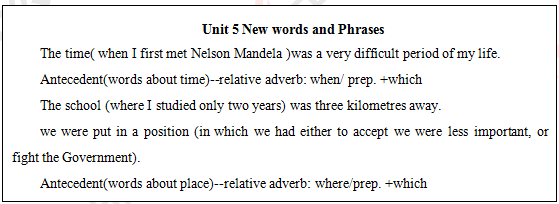
1.Which way do you think is better to learn attributive clause, do exercise or use it in oral English?
2. Do you think 'from which' in the first sentence can be replaced by 'that'?答案:解析:1.
(1)I think, first, the best way to learn attributive clause is tell the definition of this grammar in
sentence. For example, this is a beautiful teacher (who wears the red dress )is our teacher. Then ask students to pay attention to the clause to find the features of this sentence and conclude the attributive clause: noun/pronoun plus a whole sentence. Next tell the usage of pronoun in attributive clause. Last, teach the usage of adverb in attributive clause.
(2) Exercise and oral English should use togerther in practice attributive clasue. Doing exercise can make students master the structure of this grammar easily. And oral English can make students know the real situation of attributive clause in our daily life.
2.
No, I don’t think. From which is an relative adverb from the point of grammar. And that belongs to the pronoun. So it only can be used as the subject, object and so on but can not be used as the adverb or as as phrase. And this sentence doesn’t have the adverb, so we must use from which. -
第10题:
初中音乐《红河谷》
一、考题回顾
题目来源:5月18日 吉林省长春市 面试考题
试讲题目
1.题目:红河谷
2.内容:

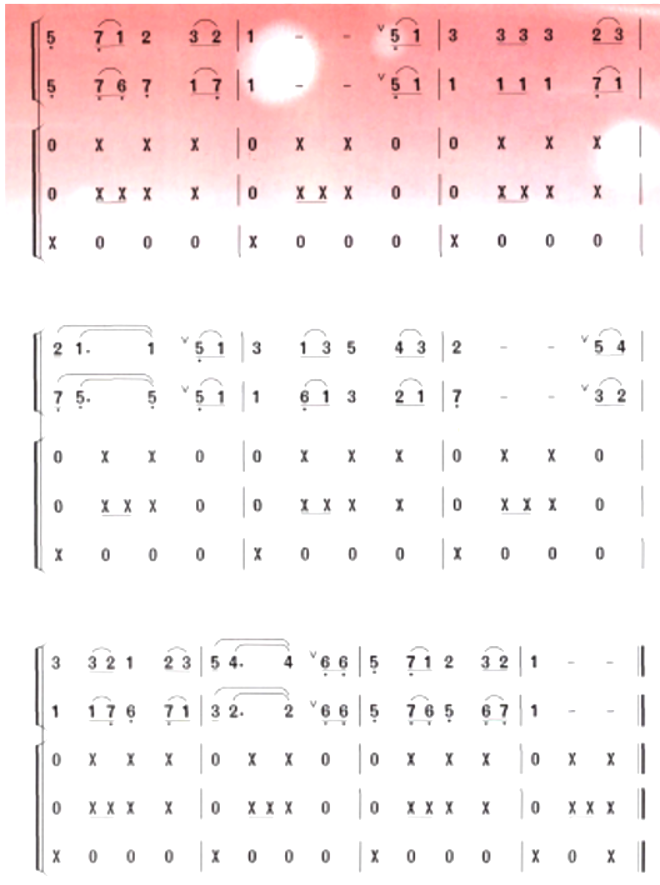
3.基本要求:
(1)试讲时间在10分钟之内完成。
(2)试讲时教师指挥演奏歌曲。
(3)试讲过程需要有适当板书。
答辩题目
1.什么是弱起小节?
2.你是应届毕业生,缺乏经验,如何能胜任音乐教学这项工作?答案:解析:二、考题解析
【教学过程】
(一)导入新课
1.游戏导入,创设情境:
分别播放几首歌曲的片段,一起猜歌曲的歌名并分别对应说出地区
《剪羊毛》——澳大利亚
《桑塔露琪亚》——意大利
《阿里郎》——朝鲜
2.总结,并引入新课:加拿大民歌——《红河谷》
(二)感知歌曲
1.播放歌曲《红河谷》的录音,熟悉歌曲的内容。并思考问题:
(1)歌曲所表达的情绪是怎样的?(优美、舒缓的)
(2)歌曲的速度、节拍各是怎样的?(中速、4/4拍)
2.再次聆听歌曲录音,听辨歌曲的结构。(划分歌曲的乐段,两部分)
(三)演奏歌曲
1.音阶吹奏练习
学生用竖笛吹奏C大调音阶,注意吹奏的方法和吐气的均匀。
2.吹奏高声部旋律
(1)教师带领学生哼唱高声部,熟悉旋律;
(2)学生尝试吹奏高声部旋律,注意连线部分的吹奏要连贯,气息保持好。
3.吹奏低声部旋律
(1)学生自行练习吹奏低声部,教师巡视指导;
(2)学生集体吹奏低声部旋律,注意时值吹够。
4.分小组进行二声部合奏练习,注意换气地方要统一,保持一致。
5.再次分组,每组又分成吹奏组和打击乐组,分发课堂打击乐器(三角铁、沙锤、鼓)。小组进行练习,教师巡视指导。
6.小组展示,教师进行指挥,引导学生合奏表演。最后,教师进行点评。
教师资格考试考前黑钻押题,瑞牛题库软件考前更新,下载链接 www.niutk.com
(四)巩固提升
1.播放合唱版《红河谷》,并与合奏版红河谷进行比较。
学生讨论回答。(利用声部的穿插、衬托,增添变化,增强厚度,丰富表现力)
2.了解我国的民歌
师:我们这节课学习的是加拿大民歌,那请同学们也来说一说我们自己国家的民歌,进行对比欣赏。(江苏民歌《茉莉花》、四川民歌《太阳出来喜洋洋》、山东民歌《沂蒙山小调》等)
(五)小结作业
今天我们学习了乐曲《红河谷》,感受了加拿大民歌的风格。课后希望大家能够搜集加拿大其他民间歌曲,课下与其他同学进行交流。
【板书设计】
红河谷
1=F 4/4
二声部合奏
连贯、统一
【答辩题目解析】
1.什么是弱起小节?
【参考答案】
乐曲由弱拍或弱位开始,并且和乐曲的最后一小节形成一个完整的小节。
计算小节数方法:由第一个完全小节算起。
从弱起小节开始的歌曲(乐曲),其后面的部分乐句或所有的乐句,也往往是弱拍起的,演唱演奏时要特别注意其句法的特点。
2.你是应届毕业生,缺乏经验,如何能胜任音乐教学这项工作?
【参考答案】
作为一个教学“新手”缺乏经验是必然的,所以针对自己的不足方面我会从以下几个方面来进行找补:
(1)不断学习教育教学相关知识,加深理论方面的底蕴,为教学实际操作打牢基础;
(2)在实际教学过程中,我会按照理论的学习与实践相结合的方法进行,并不断改进自己的授课,与学生加深交流,通过交流、互动来实际调整适合他们的教学;
(3)我会向身边有经验的教师“虚心求教”,向他们学习一些有效的教学方法和教学手段,汲取成熟的教学经验;
(4)我会认真的备好每一堂课,在熟悉了课本之后,去调整自己的授课,进而发现自己的授课风格,从而来提升自己的授课。
总之,经验是可以通过努力和实践来弥补的,我会从自己出发,加深自己的知识底蕴,并通过吸取经验,总结授课等方式不断提升自己的授课能力,从而胜任自己的教学工作。
最后,在日后的音乐教学活动中多观察学生的学习行为表现,多关注学生的情感变化,及时表扬学生,使学生增强自信,发挥音乐潜能。 -
第11题:
小学心理健康 《进步的阶梯》
一、考题回顾
题目来源:5月18日 河南省郑州市面试考题
试讲题目
1.题目:题目自拟
2.基本要求:
(1)试讲时间控制在十分钟;
(2)设置师生互动环节;
(3)试讲中要注意引导性。
答辩题目
1.一名好教师的标准。
2.心理咨询中应遵循哪些原则?答案:解析:二、考题解析
【教学过程】
(一)名言导入
高尔基说过,书籍是人类进步的阶梯对于处于新时代的我们来说,读书对我们开阔视野、增长知识是何等的重要!只有爱读书的人,才能在书中找到智慧的金钥匙。
(二)主题活动一:什么样的是好书
1.提出问题
请学生小组讨论:那什么是好书,读书应注意些什么呢?
2.交流讨论
学生分组讨论,各组总结发言。
组1:看适合我们的年龄的书,如《爱丽丝梦游仙境》《十万个为什么》。
组2:有帮助的书,比如关于练字的、写作文的。
3.教师小结
好书通常是思想性好,知识性强,趣味性浓,种类丰富,深浅适宜。
(三)主题活动二:如何阅读
1.教师提问
我们该如何阅读呢?
2.小组讨论
组1:反复多读几遍。
组2:不认识的地方查字典,不懂的地方问老师。
组3:多思考。
(四)总结升华
集体诗朗诵《神奇的书》
成长路上,有好书相伴,我们的步伐将更加稳健!成长路上,有老师、亲人陪我们共读,我们更是多么快乐和幸福同学们,让一起来记住我们的读书口号吧——我读书、我快乐、我成长!
教师资格考试考前黑钻押题,瑞牛题库软件考前更新,下载链接 www.niutk.com
【板书设计】
进步的阶梯
什么样的书是好书
如何阅读
【答辩题目解析】
1.一名好教师的标准。
【参考答案】
作为一名好教师,应该符合教师职业道德基本规范:
(1)爱国守法:热爱祖国,热爱人民,拥护中国共产党领导,拥护社会主义。全面贯彻国家教育方针,自觉遵守教育法律法规,依法履行教师职责权利。不得有违背党和国家方针政策的言行。
(2)爱岗敬业:忠诚于人民教育事业,志存高远,勤恳敬业,甘为人梯,乐于奉献。对工作高度负责,认真备课上课,认真批改作业,认真辅导学生。不得敷衍塞责。
(3)关爱学生:关心爱护全体学生,尊重学生人格,平等公正对待学生。对学生严慈相济,做学生良师益友。保护学生安全,关心学生健康,维护学生权益。不讽刺、挖苦、歧视学生,不体罚或变相体罚学生。
(4)教书育人:遵循教育规律,实施素质教育。循循善诱,诲人不倦,因材施教。培养学生良好品行,激发学生创新精神,促进学生全面发展。不以分数作为评价学生的唯一标准。
(5)为人师表:坚守高尚情操,知荣明耻,严于律己,以身作则。衣着得体,语言规范,举止文明。关心集体,团结协作,尊重同事,尊重家长。作风正派,廉洁奉公。自觉抵制有偿家教,不利用职务之便谋取私利。
(6)终身学习:崇尚科学精神,树立终身学习理念,拓宽知识视野,更新知识结构。潜心钻研业务,勇于探索创新,不断提高专业素养和教育教学水平。
2.心理咨询中应遵循哪些原则?
【参考答案】
(1)保密原则
保密原则是心理咨询中最为重要的原则,它要求心理咨询师要尊重和尽可能地保护来访者的隐私。需要明确地甚至反复地说明和解释,使之确信你是会替他保守秘密的。
(2)助人自助性原则
心理咨询帮助来访者的根本目标是促进来访者成长、自强自立,使之能够自己面对和处理个人生活中的各种问题。咨询师应该相信来访者不仅仅有获得心理健康的愿望,而且本身都具有恢复健康的能力。
(3)价值观中立原则
价值观中立原则要求心理咨询师尽量不干预来访者的价值观。
(4)综合性原则
人类心理困扰的形成是多因素作用的结果,帮助人摆脱痛苦需要多元的思考和多方面措施的干预。心理咨询的综合性原则有以下多重含义:心身的综合;原因的综合;方法的综合。
(5)灵活性原则
灵活性原则在心理咨询中具有重要意义。它要求咨询师在不违反其他咨询原则的前提下,视具体情况,灵活地运用各种咨询理论、方法,采用灵活的步骤,以便取得最佳的咨询效果。 -
第12题:
试讲题目2.题目:Adverbial clause of result
2.内容:
In fact, his English in one of these articles was so good that Engles wrote him a letter and praised him for it. He made such a rapid progress that before long he began to write articles in English for an American newspaper.
3.基本要求:
(1)根据文本讲解结果状语从句;
(2)10分钟试讲;
(3)全英授课。
答辩题目1.What will you do after this examination?
2.你认为如何给高中生上好一堂语法课?答案:解析:二、考题解析
【教案】
Adverbial clause of result
Teaching aims:
Knowledge aim:
Students can master the grammar rule of adverbial clause of result.
Ability aim:
Students will improve their analytical ability, and know how to use the grammar point.
Emotional aim:
Students will develop great interest in learning grammar.
Key and difficult point:
Key point:
The structure of “such…that” and “so…that”.
Difficult point:
Know how to analyze and summarize the grammar structure and be active in learning grammar.
Teaching procedure:
Step 1: Warming-up
1. Greetings.
2. Show students two short videos called Old Friends.
3. Ask students to watch them carefully and then to find the descriptions in different friends, in which some words or phrases like “as a result”, “so” and “therefore” are used. Later, tell students that we will learn another way to describe result. Lead to the new topic.
Step 2: Presentation
1. Ask students to read the passage and ask them two questions, “Why does Engles praised him? And why can he write articles for American newspaper?”
2. Show students a new passage and ask them to find more sentences with same structure.
3. Guide students to find the similarity among the sentences. They could work in groups of 4 for discussion.
4. Then summarize the rules: “such+a/an+adj/adv+that clause” “so+adj/adv+that clause”, and tell them that the structures are used to describe result.
Step 3: practice
Sentence master:
Divide students into four groups with ten students in each group. Ask students to have a competition by using the grammar structure to make sentences as more as they can. The group who makes sentences the most will be the sentence master.
Step 4: Production
Look and say:
Ask students to make a short story in groups of 4. Any topic is fine. They need to use the grammar point we learned today as much as possible. 5 minutes will be given before inviting a few representatives to present. Give encouragement.
Step 5: Summary and Homework
Summary: do a summary together and arouse students’ passion to learn grammar.
Homework: ask students to draw a picture of one of their friends, introduce him or her by using the grammar structure next class.
Blackboard design
Adverbial clause of result
His English was so good that Engles wrote him a letter.
He is so beautiful that everyone likes her.
He made such a rapid progress that he began to write articles for an American newspaper.
He is such a naughty boy that his father criticizes him.
Structure: such+a/an+adj/adv+that clause so+adj/adv+that clause -
第13题:
高中物理《加速度》
一、考题回顾
题目来源:5月18日辽宁省沈阳市面试考题
试讲题目
1.题目:加速度
2.内容:
3.基本要求:
(1)在十分钟内完成试讲;
(2)有实验要有教师演示;
(3)注意试讲过程中要有师生提问互动环节。
答辩题目
1.如何利用v-t图像找出加速度?
2.本节课的教学重难点是什么?答案:解析:二、考题解析
【教学过程】
环节一:新课导入
播放一组视频:飞机在蓝天平稳飞行;火车出站逐渐加速,经过一段时间,风驰电掣;赛车冲出起跑线,很快就高速行驶;运载火箭点火起飞,引出课题。
环节二:新课讲授
1.速度变化量和速度变化率
提出问题完成表格。小车A在20s内速度达到了100 km/h,而旅客列车达到这个速度大约要用500s。谁的速度变化量大?谁的速度“增加”得比较快?学生和教师一起完成表格。
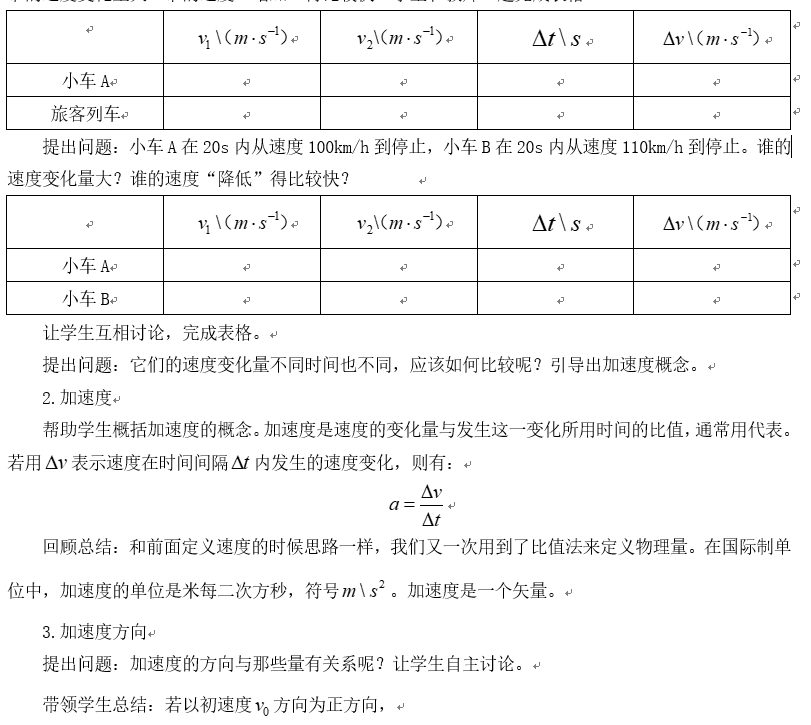

教师资格考试考前黑钻押题,瑞牛题库软件考前更新,下载链接 www.niutk.com
A.物体运动的速度改变量很大,它的加速度一定很大
B.速度很大的物体,其加速度可以很小,可以为零
C.某时刻物体的速度为零,其加速度不可能为零
D.加速度很大时,运动物体的速度一定很大
环节四:小结作业
提出问题:我们今天学习了哪些知识?
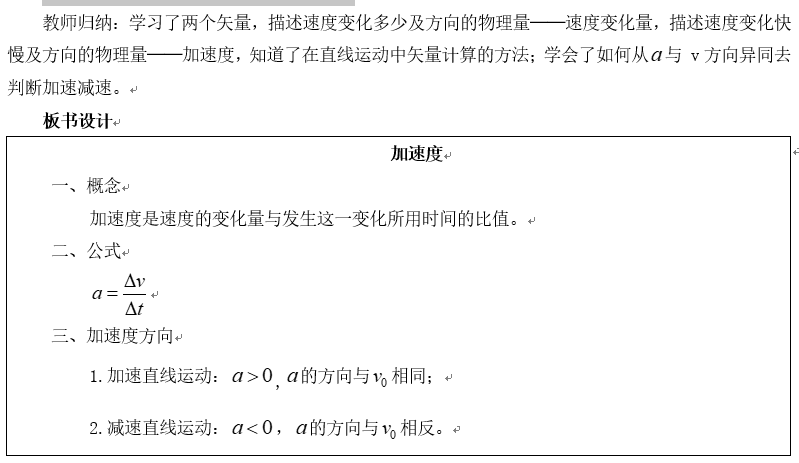
【答辩题目解析】
1.如何利用v-t图像找出加速度?
【参考答案】
当直线呈上升趋势时,表示加速;而当直线呈下降趋势时,表示减速。
从直线的斜率能看出加速度的大小,直线越陡峭加速度越大;
2.本节课的教学重难点是什么?
【参考答案】
重点:掌握理解加速度的概念和物理意义;
难点:速度、速度的变化和速度变化快慢之间的区别与联系。 -
第14题:
初中数学《三角形中位线的定理》
一、考题回顾
题目来源:5月19日 上午 广东省 面试考题
试讲题目
1.题目: 三角形中位线的定理
2.内容:
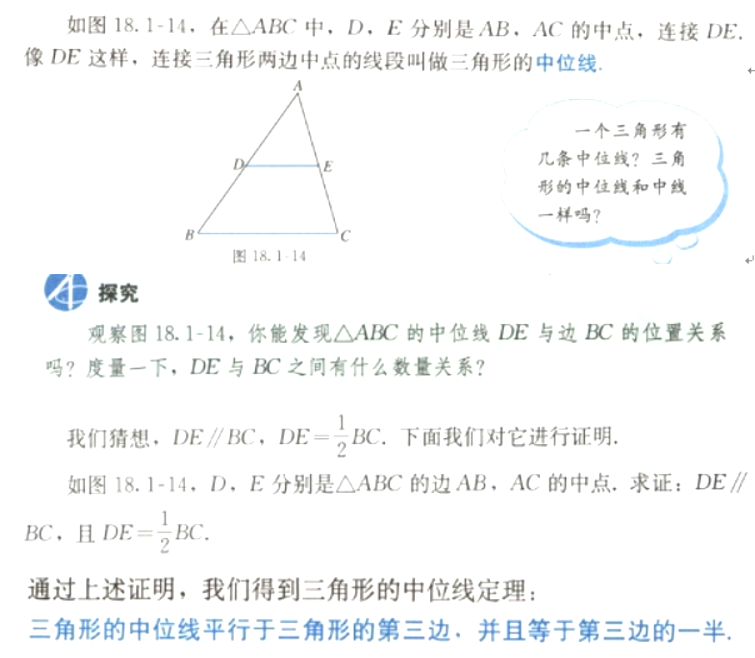
3.基本要求:
(1)试讲十分钟左右;
(2)要有板书;
(3)明确目的,思路清晰;
(4)让学生经历中位线定理的探究过程,并能证明。
答辩题目
1. 为什么要学习三角形中位线?
2. 在课堂中,怎样培养学生的观察力呢?答案:解析:二、考题解析
【教学过程】
(一)导入新课
拿出一个三角形的纸板,让学生找出三边的中点,连接这6点中的任意两点,找一找哪些是已经学过的,哪些是没有学习过的。
引出课题。
(二)新知探索
1.介绍三角形的中位线
连接三角形两边中点的线段叫做三角形的中位线。

提问:一个三角形有几条中位线?三角形的中位线和中线一样吗?
2.探究三角形的中位线定理
观察上图,你能发现△ABC的中位线DE与边BC的位置关系吗?度量一下,DE与BC之间有什么数量关系?
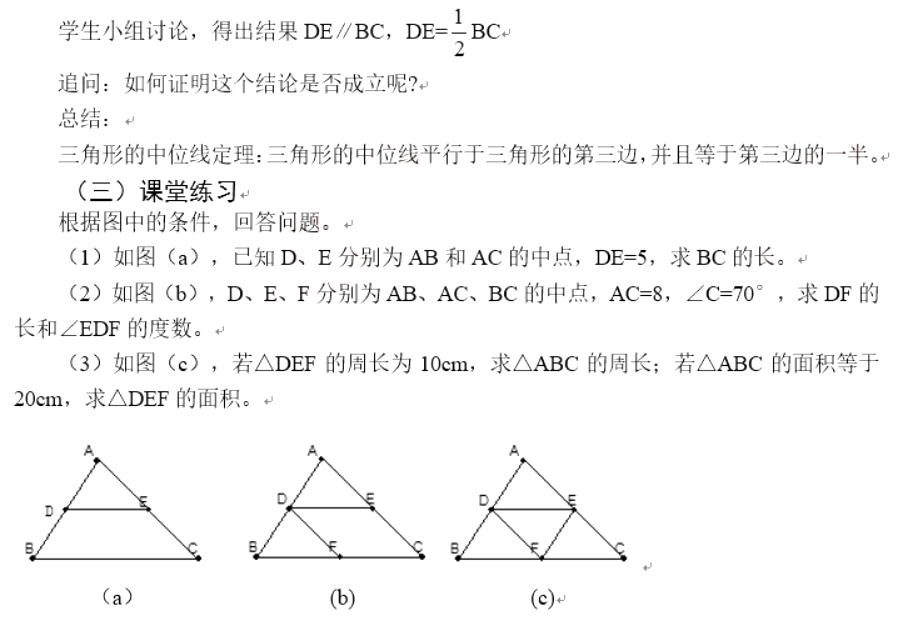
【答辩题目解析】
1. 为什么要学习三角形中位线?
【参考答案】
三角形中位线是三角形中的重要线段,三角形中位线定理是一个非常的重要性质定理,它是前面已学过的平行线、全等三角形、平行四边形等知识内容的应用和深化,对进一步学习非常有用,尤其是在判定两直线平行和论证线段倍比关系时常常用到。在三角形中位线定理的证明及应用中,处处渗透了化归思想,它是一种重要的思想方法,无论在今后的学习还是在科学研究中都有着重要的作用,它对拓展学生的思维有着积极的意义。
2. 在课堂中,怎样培养学生的观察力呢?
【参考答案】
第一、在观察中及时指导。比如:要指导学生根据观察的对象有顺序地进行观察,要指导学生选择适当的观察方法,要指导学生及时地对观察的结果进行分析总结等;第二、要科学地运用直观教具和现代多媒体教学技术,以支持学生对研究的问题做仔细、深入的观察;第三、要努力培养学生浓厚的观察兴趣。 -
第15题:

二、考题解析
【教案】
Teaching Aims
Knowledge aims
Students will know the form and usage of attributive clause lead by who, which and that.
Ability aim
Students can enhance their ability of understanding the knowledge which is more professional and difficult.
Emotional aim
After this lesson, students will improve their confidence of learning English.
Teaching Key &Difficult Points
Key point: attributive clause;
Difficult point: How to understand and use the attributive clause.
Teaching procedures
Step 1: Warming up
Show some adverbial clause on the screen, let students look at this sentences carefully and find the similarities among them. After observation, do a conclusion together :“They all describe the verbs like adverbs.”
I will call you as soon as I arrive in Beijing.
Where you work, you should work hard.
My friends like me because I’m honesty.
Step 2: Presentation
Show these four sentences on the blackboard.
1.Students try to translate these sentences. Invite some students to share their answers. The answers are as follows:
正在踢足球的男孩是一班的。
昨天我帮助了一位迷路的老人。
足球是大多数男孩所喜欢的运动。
他喜欢外国作家写的书。
2. Let them observe these two sentence, find the common between them. Tell them the function and meaning of attributive clause.
The rules are shown in the following part:
① The function of attributive clause is to modify the previous word (antecedent).
② When the antecedent is human being, we should use the relative pronoun: who.
③ When the antecedent is something, we should use the relative pronoun: which.
④ No matter the the antecedent is something or someone, the relative pronoun: that can be used.
Step 3: Practice
1.Give them several minutes to make their own sentences using attributive clause.
2.Read the some sentences and try to translate them.
Step 4: Production
Divide them into group of four and in five minutes to discuss the impressive person who has made great influence on you. Try to use the attributive clause.
Step 5: Summary & Homework
1.Ask students to summarize the usage and function of attributive clause.
2.After class, please search more information about attributive clause.
Blackboard design
 答案:解析:暂无解析
答案:解析:暂无解析 -
第16题:
初中英语 词汇
一、考题回顾
题目来源:5月19日 上午 山东省 青岛市 面试考题
试讲题目
1.题目:词汇教学试讲
2.内容:This man is from Canada.He is twenty years old.He is tall and he has brown hair.He has small eyes,a big nose and a wide mouth.He is in black clothes.Please help us find him.Our phone number is (902)877-3641
3.基本要求:
(1)朗读所给材料
(2)全英10分钟试讲
(3)适当板书
(4)针对所给材料划线部分,设计运用类词汇教学活动
答辩题目
1. How do you help students accumulate vocabularies?
2. How do you help improve students’ English ability?答案:解析:二、考题解析
【教案】
Teaching aims:
Knowledge aim:
Students will master the the meaning of the phrases, such as : small eyes, big nose and wide mouth and so on.
Ability aim:
Students will use the words to describe others in their daily life.
Emotional aim:
Students will be interested in learning English.
Students will be more confident in speaking English.
Key and difficult point:
Key Point:
Students will grasp the meaning of the new words.
Students will use the words in their daily life and describe others.
Difficult Point:
Students will be interested in learning English and not afraid of speaking English in front of others.
Students will be more confident in speaking English.
Teaching procedure:
Step 1: Warming-up
1. Greetings. Talk about the weather.
2. Sing a song Head, shoulder, knees and toes
Head shoulders knees and toes
Knees and toes
Head shoulders knees and toes
Knees and toes
And eyes and ears and mouth
And nose
Ask the students if they are excited after this song, tell them there are some words about the parts of our body in this song. Then introduce today’s topic.
Step 2: Presentation
1. Draw some pictures of the new words on the blackboard.Introduce the words and explain the meaning with touching the parts of our body. Lead the students read the new words for twice or three times.
New words: ear, eyes, nose, mouth hair
2. Read the passage for the students, let them add the adjectives of the new words. Then the words change to phrases.
Phrases:cute ear, small eyes,big nose, wide mouth brown hair
3. Lead in the new sentence and explain the usage of it: he has...
Step 3: Practice
1. Play a game called “magic eyes”,when teacher touch the part of the body, students should react quickly and say the words.Then teacher will do the actions faster, students should say the words faster.
2. Play a game “what’s missing”. Show some pictures of cartoon character and ask them “What’s missing”.(Doraemon has no ear, Hello kitty has no mouth)
3. Teacher describe the students in the class, use the sentences “He has ...”, let the students guess who he/she is.
Step4: Production
1. Draw and guess. They need to work in pairs for the game. One student should draw the organs and present its feature. Then the other student should guess what he is drawing and read the words correctly. 3 pairs will be invited to play the game. The pair finishing the game with the shortest time is the winner.
2. Role-play. Work in pairs. Student A and student B should describe each other. They need to make a presentation according to the given words. Invite one pair to make the presentation.
Step5: Summary and Homework
Summary: Make a brief summary of what we have learned with students.
Homework: Draw the pictures and write down the according words, and hand it to the teacher tomorrow.
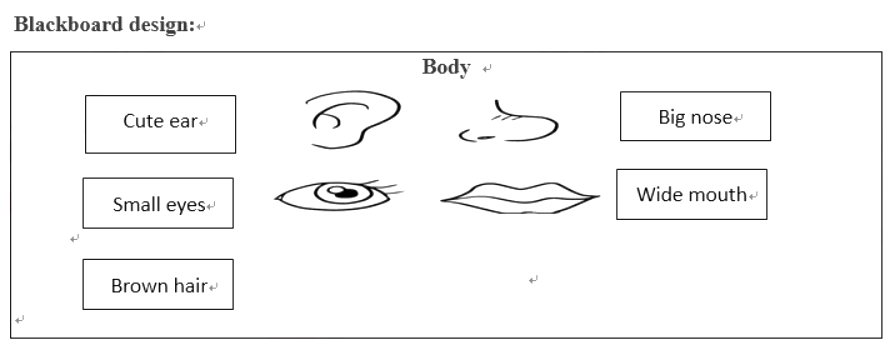
【答辩题目解析】
1.How do you help students accumulate vocabularies?
【参考答案】
First, these words can be introduced in a funny way, just like what I have done in the presentation part. This will deepen the memory of each word. Second, exercises must be conducted to consolidate the words. Then, after class, they should do some homework. Also, these words need to be review on a regular basis, so that they won’t forget them easily.
【答辩题目解析】
2. How do you help improve students’ English ability?
【参考答案】
First, interest must be aroused in learning English. Without passion in English, they will learn it passively and will not receive good result. So I will arrange different activities to attract their attention. Second, they need to learn knowledge step by step. So I will impart knowledge from input to output, namely, from presentation to practice and production. Output is essential, because a word can truly leave a deep impression on students when they use it. By doing this, they will absorb the knowledge gradually. So in my opinion, students can improve their English ability through the above two steps.
[page] -
第17题:
一、考题回顾
题目来源:1月6日下午湖北省武汉市面试考题
试讲题目:草原就是我的家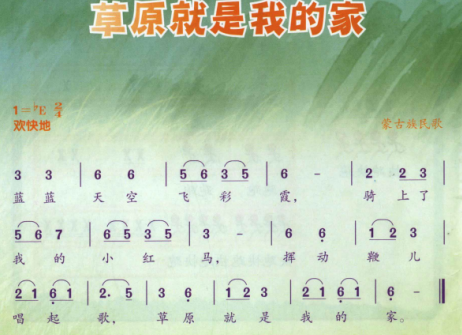
3.基本要求:
1.示范弹唱
2.试讲过程 中,要有互动
3.板书展示
4.试讲10分钟
答辩题目:这首歌是什么小调?答案:解析:【教学过程】
(一)情景导入,引出新课
(1)播放《牧歌》伴奏音乐,学生伴随音乐律动,走进教室。
(2)通过介绍歌曲及蒙古族,揭示课题《草原就是我的家》。
(二)学唱歌曲,探究学习
(1)播放视频,并演唱歌曲,体会歌曲中描绘的美丽风光,感受优美、抒情的旋律。
(2)老师范唱歌曲,学生跟着小声哼唱,认识附点音符。
(3)老师弹伴奏,再由学生进行跟唱。在唱的过程中学习延长音。并且教师对延长音进行讲解。
(4)讲解延长音。在讲解后学生紧跟老师进行节奏的拍打,在此环节,学生便已基本掌握。而后将学生分为四个小组进行练习。
(5)检查学生的练习效果。
(6)学唱歌词
①随伴奏有感情地轻声读歌词;
②随伴奏轻声默唱歌词2遍。
(7)老师再次弹伴奏,学生跟着琴完整的演唱歌曲。(要求:优美、抒情)
(8)欣赏蒙古族美丽景象的视频,引导学生感受蒙古的美丽,进一步指导学生带着感情演唱歌曲。
(三)拓展延伸,表现歌曲
(1)教师范唱(加律动),学生表演唱,交换唱
巩固今天学习的内容,有感情地表演唱。
(2)请学生们自由表演唱(跟录音视频)
(3)播放视频,介绍那达慕大会
(4)分组模仿那达慕大会项目
(播放背景音乐)赛马、摔跤、射箭
提问同学们都看到了哪些比赛项目,做简单的介绍,并分组进行模仿表演。
(5)用木棒打节奏,边唱边跳
(四)小结作业
师:教师请同学们总结今天学习了哪些内容,并在歌声中,模仿骑着马儿的动作走出教室。
【板书设计】
【答辩题目解析】
这首歌是什么小调?
【参考答案】
《草原就是我的家》。这首歌曲本身是bE宫调式的歌曲,但是最后的尾音却落在了6上,所以是一个C徵五声调式。 -
第18题:
初中音乐《中国梦》
一、考题回顾
题目来源:5月18日 辽宁省沈阳市 面试考题
试讲题目
1.题目:中国梦
2.内容:

3.基本要求:
(1)试讲时间在10分钟之内完成。
(2)试讲时需要有情感交流环节。
(3)试讲过程需要有创编环节。
答辩题目
1.简单介绍你知道的速度记号。
2.本节课你的教学目标是什么?答案:解析:二、考题解析
【教学过程】
(一)情境导入
教师创设情境,播放歌曲《歌唱祖国》,并对学生进行提问:这首歌曲给你什么样的感觉?表达怎样的情感?
学生自由发言。
教师总结:这首歌曲给人一种欣欣向荣的感觉,表达人们强烈的爱国主义情感。
引入课题——《中国梦》。
(二)感受体验
1.初听歌曲,教师播放张也演唱的《中国梦》。
并设问:“歌曲的旋律如何,歌曲描绘了一幅怎样的画面?”
学生自由发言。
教师总结:歌曲旋律较为中速、欢快,描绘了一幅天下大同、和谐社会的展望情景。
2.复听歌曲
并设问:“歌曲给你一种什么样的感觉?”
学生自由发言。
教师总结:这首歌曲主要表达对美好社会的向往之情,坚定强烈的节奏感,仿佛感受到祖国的大好河山、繁荣昌盛的场景,给人一种自豪感。
(三)探究学习
1.进行简单发声练习,例如:1 2 | 3 2| 1 - |。
2.教师范唱歌曲,学生小声哼唱,感受旋律的流动。
3.教师弹奏钢琴,学生跟唱乐谱,并提示学生注意连音记号及速度的转换。
4.教师引导学生进行演唱,边唱歌边打拍子,帮助学生掌握速度的变化,并提问学生:“不同的速度变化,对于音乐造成了怎样的影响?”
学生自由回答。
教师总结:刚开始速度为中速,优美抒情;中间速度转为稍快,将歌曲情绪逐渐推强,情绪高涨;最后速度由快速转为中速稍快,首尾呼应的同时,更好的强调情感。
5.完整有感情地演唱乐谱。
6.教师带领学生熟悉歌谱之后,有感情的朗诵歌词,并提问学生:“歌曲表达怎样的情感?”
学生自由回答。
教师进行总结:歌曲通过对于中国人们的描述和文化的传承,表达对于祖国的赞美及美好生活的向往之情,传达着强烈的爱国主义情怀。
7.教师请学生分组进行竞赛演唱,并进行鼓励性评价。
(四)巩固提高
教师将学生进行分组,用自己的方式来表达对于祖国的热爱及赞美之情,并提醒学生注意与组内其他成员的配合。创编完成后请各组进行表演,并互相评价,教师进行总结评价。
(五)小结作业
今天我们学习了歌曲《中国梦》,感受到强烈的民族自豪感,希望同学们通过本课的学习能够感受祖国的繁荣昌盛,逐渐具有传承发展意识。
请同学们课后收集关于祖国的作品,下节课互相分享。
【板书设计】
中国梦
连音线
第一部分:中速、稍慢;优美抒情
第二部分:快速;情绪高涨
第三部分:中速、稍快;强调情绪
美好生活的向往、热爱祖国
【答辩题目解析】
1.简单介绍你知道的速度记号。
【参考答案】
速度记号一般记在乐曲或乐章的开端五线谱的上面,记法一般是意大利文和本国文字通用。包括基本速度和变化速度两种:
基本速度记号记在乐曲或段落的开始,用来标记全曲或整段音乐的速度;有庄板(每分钟40拍)、广板(每分钟46拍)、慢板(每分钟52拍)、柔板(每分钟56拍)、小广板(每分钟60拍)、行板(每分钟66拍)、小行板(每分钟69拍)、中板(每分钟88拍)、小快板(每分钟108拍)、快板(每分钟132拍)、急快板(每分钟160拍)、急板(每分钟184拍)、最急板(每分钟228拍)
变化速度是用来标记乐曲进行中速度的改变。有渐慢、渐快、原速、速度自由等。
2.本节课你的教学目标是什么?
【参考答案】
情感态度价值观:感受歌曲《中国梦》,体会歌曲中对于美好生活的向往及热爱祖国的情感,学生能够产生传承民族音乐文化的意识。
过程与方法:学习过程中运用聆听、表现、合作等方法,学生能够完整表现歌曲并能提升音乐表现能力。
知识与技能:能够准确唱出连音线的连贯感,并能够掌握速度表达时情绪的变化;体会歌曲表达的爱国主义情感,从而能够完整地有感情地演唱歌曲。 -
第19题:
试讲题目3.题目:Visiting a school
2.内容: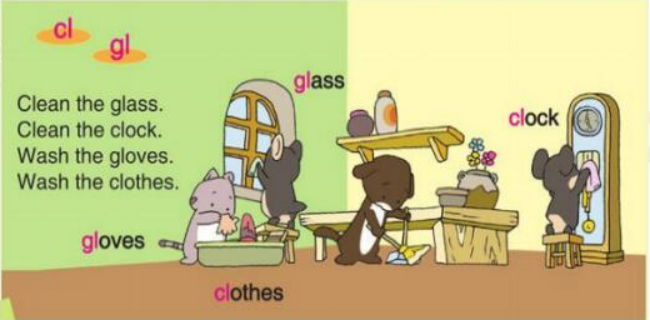
3.基本要求:
(1)设计为语音课;
(2)运用韵律进行授课,多做游戏活动课堂氛围;
(3)全英授课,试讲时间10分钟。
答辩题目1.如果学生没完成你的作业,还找借口,你怎么处理?
2.对于板书,你觉得有哪些优化的地方?答案:解析:二、考题解析
【教案】
Visiting a school
Teaching aims:
Knowledge aims:
Students will master the pronunciations and differences in the letter groups “gl” and “cl”.
Students can grasp the meanings of some words like “glass”, “gloves”, “clock” and “clothes”.
Ability aims:
Students will know how to pronounce “gl” and “cl” in words.
Students will improve their speaking ability through chant.
Emotional aims:
Students will improve their interest in learning English, and be fond of taking part in all kinds of class activities.
Students can learn to give their parents a hand in doing housework.
Teaching key and difficult points:
Key point: to master the pronunciations of these two letter groups, and know how to pronounce them in words.
Difficult point: to discriminate these two letter groups in speaking, and improve their confidence in learning English.
Teaching procedures:
Step 1: Warming-up
1. Greetings. Talk about the weather.
2. Share a riddle with students:
I have a big round face.
I have no legs but I can walk.
I have no mouth but I can say “tick-tock”, “tick-tock”
Ask the answer of this riddle (clock), and tell students that we are going to learn something about the related pronunciation.
Step 2: Presentation
1. Present the words with the help of pictures on the screen.
2. Let students find the similarities among the words and share their answers. Then let them listen to the tape and find out the differences of these two letter groups in pronunciation.
3. Explain the pronunciation rule: if we meet the letter groups of “gl” and “cl” in words, we often pronounce [gl] and [cl] respectively. Then ask students to pay attention to the differences by watching the teacher’s mouth and imitate.
Step 3: Practice
Play a game called Send Words Home. Present the words on the PPT, and draw two houses of the letter groups “gl” and “cl” on the blackboard. Five students in a group are to have a discussion in three minutes about where the words on the PPT belong to. Then invite some students to the front to write down their answers, and read them aloud. Check answers and give evaluations.
Step 4: Production
Ask students to make a chant based on the words that we learned today. Work in groups of four in five minutes. Later, invite some students to share their chants. For example:
Clock, clock, clock on the wall
Clothes, clothes, clothes on the bed
Glass, glass, glass on the window
Gloves, gloves, gloves on the hands
Give evaluations and encouragements.
Step 5: Summary and Homework
Summary: ask a student to conclude the content of today's lesson, then tell them to form a good habit of giving parents a hand in housework.
Homework: let students share the chant with their parents, and try to create a story based on the words that we have learned today.
Blackboard design:

Teaching reflection -
第20题:
高中心理健康 《归因方式》
一、考题回顾
题目来源:5月18日 河北省张家口市面试考题
试讲题目
1.题目:归因方式
2.内容:
3.基本要求:
(1)试讲时间控制在十分钟;
(2)活动中关注学生的感受变化;
(3)试讲中要注意引导性。
答辩题目
1.你的教学目标和教学重难点是什么?
2.请说一说高中生自我意识发展的特点。答案:解析:二、考题解析
【教学过程】
(一)热身活动:左手氢气球,右手铅球
1.规则介绍
请大家闭上眼睛跟随老师的指导语想象。
指导语:深呼吸,现在请将你的双手伸直放在胸前,尽量伸直,掌心朝上,并使双手保持在同一高度。请跟着我的话语在脑海中想象,在你的左手有一个氢气球,右手是铅球。左手的氢气球很轻、很轻……右手的铅球慢慢膨胀,越来越重,你快要托不住它了。好,现在睁开眼睛,观察自己的手,是不是发生了变化?
2.分享交流
师:你发现了哪些变化,为什么会有这样的变化?你受到了什么启发?
生1:我的右手远远低于左手。我刚才一直在想象右手有个铅球,很重很重,不知不觉中右手就沉下去了。
生2:自己的想象却会对事情造成很大的影响。
教师小结:同学们都发现了自我暗示的作用,积极的自我暗示能让我们充满信心和力量,促进任务的完成。
(二)主题活动一:心灵故事
1.故事介绍
亮亮和小华是好朋友。本来二人成绩相当,都处于中上等水平。但在最近的一次考试中,亮亮没有考好,小华考了第二名。亮亮认为是自己脑子太笨了;小华则认为自己虽然考得不错却是凭运气。在接下来的考试中,亮亮成绩仍然不理想,而小华也退步了。
2.交流讨论
师:你认为二人失败的原因有哪些?
生:他们对自己没考好的分析不利于自己积极努力。
教师小结:将成功归结为努力,这是积极的归因方式;如果将成功归结为运气就属于消极的归因方式。
(三)主题活动二:归因训练
1.规则介绍
请大家想一想你最近一次的考试结果,你满意吗,你认为那次考试成功/失败的原因是什么?
2.小组讨论
师:你的积极归因有哪些作用,消极归因又有哪些影响?
生1:消极的归因方式妨碍成绩的提高,恶性循环,体验到更多的失败与挫折;而积极的归因会促进人更加努力,最终达到好的结果。
教师小结:通过活动我们了解到积极的归因可以让我们更加自信,感到自豪,有成就感;而消极的归因容易让我们丧失信心,失去做事情的动力和勇气。
(四)总结升华
本次课程就要结束了,请大家闭上眼睛,安静地想一想,这节课中给你留下最深印象的是什么,通过本次课程的学习,你都有哪些感想。
【板书设计】
归因方式
积极归因
消极归因
【答辩题目解析】
1.你的教学目标和教学重难点是什么?
【参考答案】
本课,我设置的教学目标如下:
①通过体验自我暗示认识到积极自我暗示对自己的作用。
②通过归因训练掌握积极归因方式,从而不断完善自我。
本课,我的教学重难点如下:
①教学重点:认识到积极自我暗示、积极归因的作用。
②教学难点:能在日常生活中对自己进行积极自我暗示、积极归因。
2.请说一说高中生自我意识发展的特点。
【参考答案】
第一,自我意识中独立意向的发展。高中生已能意识到自己是一个独立的个体,要求独立的愿望日趋强烈。
第二,自我意识成分的分化,高中生在心理上把自我分成了“理想的自我”和“现实的自我”两个部分。
第三,强烈地关心着自己的个性成长。高中生十分关心自己个性特点方面的优缺点,在对人对己的评价时,也将个性是否完善放在首要位置。
第四,自我评价的成熟。高中生能独立地评价自己的内心品质、评价行为的动机及效果的一致性情况等,其自我评价在一定程度上达到了主客观的辩证统一。
第五,有较强的自尊心。高中生在其言行受到肯定和赞赏时,会产生强烈的满足感;反之,易产生强烈的挫折感。
第六,道德意识的高度发展。
总之,高中生在自我观察、自我评价、自我监督、自我控制等自我意识的成分上都获得了高度的发展,并趋于成熟。 -
第21题:
小学数学《周长》
一、考题回顾
题目来源:1月6日下午河北省秦皇岛市面试考题
试讲题目:《周长》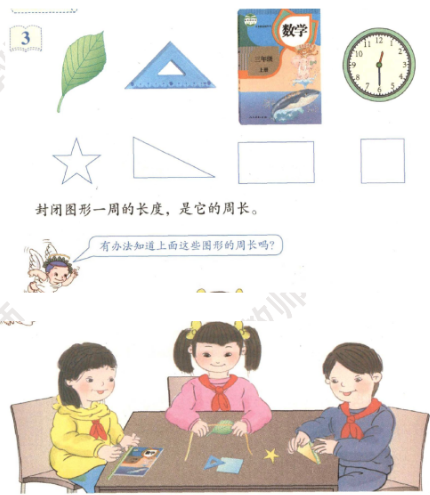
3.基本要求:
(1) 试讲10分钟;
(2) 让学生初步了解周长的含义;
(3) 要有过程性评价。
答辩题目
1.你是如何让学生理解周长的含义的?
2.如何测量图形的周长?答案:解析:
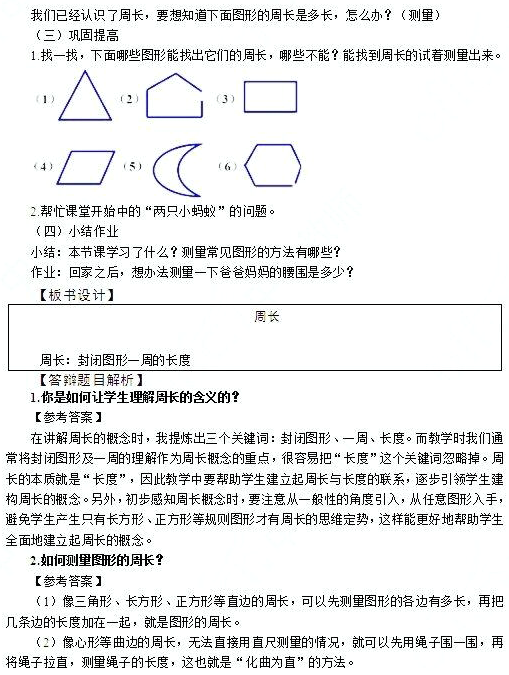
-
第22题:
初中英语 语音
一、考题回顾
题目来源5月19日 上午 河北省 石家庄市面试考题
试讲题目1.题目:语音教学试讲
2.内容:
I have a pet cat.
Her name is Pat.
She gets a present from my dad.
Is she happy about it?
No, she was sad.
3.基本要求:
(1)朗读所给内容。
(2)配合教学内容适当板书。
(3)讲解元音的区别。
(4)用英文试讲。
(5)试讲时间:10分钟
答辩题目
1. In your opinion, how can junior high school students learn pronunciation well?
2. How to cultivate students’ sense of pronunciation?答案:解析:二、考题解析
【教案】
Teaching aims:
Knowledge aim:
Students can master the difference between the pronunciation of letter ‘e’ and ‘a’.
Ability aim:
Students can use the pronunciation rules into daily communication.
Emotional aim:
Students can be more interested in learning English.
Key and difficult point:
Key Point:Students can master the difference between the pronunciation of letter ‘e’ and ‘a’.
Difficult Point: Students can use the pronunciation rules into daily communication.
Teaching procedure:
Step 1: Warming-up
1. Greetings.
2. Have a free talk with students talk about the present that they received before and their feelings about it.
Step 2: Presentation
1. Ask students to read the dialogue and pay attention to the underlined words in the conversation.
2. Review the underlined word with students by invite some of the students to explain the meaning or imitate the words. And write it down on the black board respectively.
3. Divide the words into two groups and ask students to find out the similar letter in each group
4. Lead the students to find the rules of the pronunciation of letter ‘e’ and letter ‘a’ in the stressed close syllable. Conclude the difference between the two sound
Step 3:Practice
1. Read the words on the black board and lead students to repeat after the teacher.
2. Read some words and let students to pick out the words where the pronunciation is ‘e’.
fat set rat
vet get pattern
Step4: Production
1. Ask students to find more words that pronoun ‘/e/’ and ‘/?/’ and divide them into two groups.
2. Ask students to make a dialogue talk about their favourite gift and pay attention to the pronunciation of letter ‘e’ and ‘a’.
Step 5: Summary and Homework
Summary: Ask a student to conclude the content of the lesson and summarize with the whole class.
Homework: Ask students to find more pronunciation of letter ‘e’ and letter ‘a’

【答辩题目解析】
1. In your opinion, how can junior high school students learn pronunciation well?
【参考答案】
As for the students, they have learned English for several years, so they have accumulated some pronunciation knowledge, but they may be lacking in the differences of some similar sound, and they sometimes can’t distinguish the sound by themself. So it is very important for the teacher to lead them to the rules and let them to find the rules, which can both help them to improve the ability study on their own and master the knowledge the same time.In this way, students can learn pronunciation well.
2.How to cultivate students’ sense of pronunciation?
【参考答案】
It is one of the strategies of teaching listening to cultivate students’ sense of pronunciation. Following are the methods. Firstly, students should listen to the tape to imitate the correct pronunciation. Secondly, students should pay more attention to the change of pronunciation in the process of communication. Thirdly, the listening materials should be authentic, just as in real-life listening. -
第23题:
一、考题回顾
题目来源:1月6日下午浙江省温州市面试考题
试讲题目:小乌鸦爱妈妈
3.基本要求:
1.有教唱歌曲的环节
2.有教师弹唱环节
3.要体现师生互动
4.10分钟试讲
答辩题目:
1、本节课有哪些”即兴编创“的内容?
2、你觉得该怎样抓住这堂课的重点?答案:解析:【教学过程】
(一)激趣导入,引出新课
老师带着乌鸦头饰,用设疑的方式提问学生:“你们知道我是谁吗?”引出主题《小乌鸦爱妈妈》。
(二)新课教学,深入学习
1.欣赏视频
(1)欣赏视频,体会乌鸦妈妈的爱。
(2)欣赏视频,感受小乌鸦的孝心。
2.欣赏歌曲
老师设置问题:听了这首歌之后有什么感受?
学生自由回答。
老师归纳总结:这是一首非常动人的歌曲,轻快的优美的旋律为我们展示了小乌鸦爱妈妈,为妈妈找虫子、喂妈妈的情景,让我们一起走进小乌鸦的世界。
3.朗读歌词,体会歌词意境
老师引导:乌鸦妈妈不能飞伤心难过的心情,以及小乌鸦可以为妈妈闯天下找虫子、为妈妈的感人的画面。
4.学唱歌曲
(1)再次欣赏歌曲,根据歌曲画旋律线,感受音乐情绪。
(2)老师弹唱歌曲,学生小声跟唱。
(3)老师逐句的弹奏,学生用“啦”模唱。
老师纠正:声音轻快、轻巧一点,高音的地方轻轻的演唱,声音连贯一些。歌唱的旋律要清晰,注意音要唱准。
(4)老师逐句的弹奏钢琴,学生逐句跟着音乐填词。
(5)学生完整的根据钢琴演唱。
老师做示范,学生评价:歌曲唱的非常非常轻快、动听,很优美。
老师引导:老师用了亲切自然的声音去演唱,非常重要的一点就是要有感情,
(6)设置接龙游戏
①师生演唱,老师唱上半句,学生唱下半句。
②学生分小组演唱,一组唱上半句,一组唱下半句。
(三)巩固提高
1.为歌曲创编动作
老师设置问题:我们可以用歌声把我们的故事唱出来了,能不能用动作把我们的故事表演出来呢?
学生自由回答。
(1)学生根据歌词创编动作。
(2)学生之间相互评价。
老师归纳总结:动作要做的清晰,要和歌词的内容一致,而且动作表演的要形象。
(3)学生跟随歌曲表演舞蹈动作。
2.为歌曲创编歌词
老师设置问题:你们最喜欢什么样的小动物?请把小乌鸦换成自己喜欢的动物,给我们的歌曲编创新的歌词,小组讨论、创编歌词并表演。
(1)学生开始小组讨论。
(2)小组表演自己创编的歌词。
(3)学生互评。
老师归纳总结:有的小组唱的非常动听,有的小组创编的歌词很美,想得非常独特,但是唱的再活泼、轻快一点就更好了。
3.情感激励,爱的教育
老师设置问题:同学们通过这节课的学习你们有什么感想那?从小乌鸦的身上学到了什么?
学生自由回答。
老师归纳总结:同学们都是懂事的孩子,我们不单要爱妈妈、爱长辈、爱同学,更要帮助有需要的人,做一个爱祖国、听妈妈话的好孩子,只要我们多付出一点爱,我们的世界会更加的美好,同学们老师相信你们一定会做到。
(四)课堂小节
今天我们也想小乌鸦一样感受到了妈妈的爱,而且非常愿意照顾妈妈,帮助他人,请让我们再次唱起小乌鸦结束今天的音乐课。
【答辩题目解析】
1.本节课有哪些“即兴编创”的内容?
即兴编创关键在于即兴,在具体的教学活动中,教师不必过分拘泥于形式和结果,主要目标应放在培养和锻炼学生的创造意识方面。
本节课的“即兴编创”教学涵盖的内容有以下几点:
1.编创表演动作。这是目前中小学音乐教学中普遍采用的方式,往往与演唱教学相结合,如在学唱《小乌鸦爱妈妈》时,学生根据歌词创编动作,以律动、歌舞表演等形式表现歌曲,增强歌曲的演唱的艺术表现力。
2.为歌曲创编歌词。这对小学音乐课也是最常见的教学方式之一,一般是结合感受、欣赏和表现来进行。比如,在学唱完《小乌鸦爱妈妈》之后,即兴编创歌词,以丰富音乐表现,增加歌曲的情趣,锻炼和发展学生的创造性思维。
2.您觉得该怎样抓住这堂课的重点?
《小乌鸦爱妈妈》的教学重点是熟唱歌曲。
本节课是一节教唱课,所以在整个教学过程中我设置的所有的环节都是围绕着学唱歌曲展开。
在新课教授环节,首先我引导学生通过欣赏《小乌鸦爱妈妈》的音乐视频,通过聆听、观看,体会歌曲表达的音乐情绪和故事中小乌鸦对乌鸦妈妈的孝心之后学生有节奏朗读歌词,体会歌曲中节奏特点;在教唱环节我再次引导学生通过拍手律动,聆听歌曲和由我范唱,学生小声跟唱,学生通过拍手和小声跟唱,逐步熟悉歌曲的旋律和节奏的问题,接着我引导学生逐句的用“啦”模唱,通过用正确的演唱方法解决歌曲中音准的问题,之后我引导学生在逐句的填词,在学生熟悉歌词之后,我弹琴学生完整的演唱,学生再次聆听歌曲,感受歌曲的音乐情感,最后我设置旋律问答的游戏,师生旋律问答和学生旋律问答,逐步熟悉歌词、旋律,在巩固提高环节我引导学生编创表演动作,一边表演一边歌唱,再次演唱歌曲。
学生通过接触、体会、参与多个活动一遍遍的学唱歌曲,由浅入深、由陌生逐步的熟悉歌曲,从而完成本节课的教学重点。
